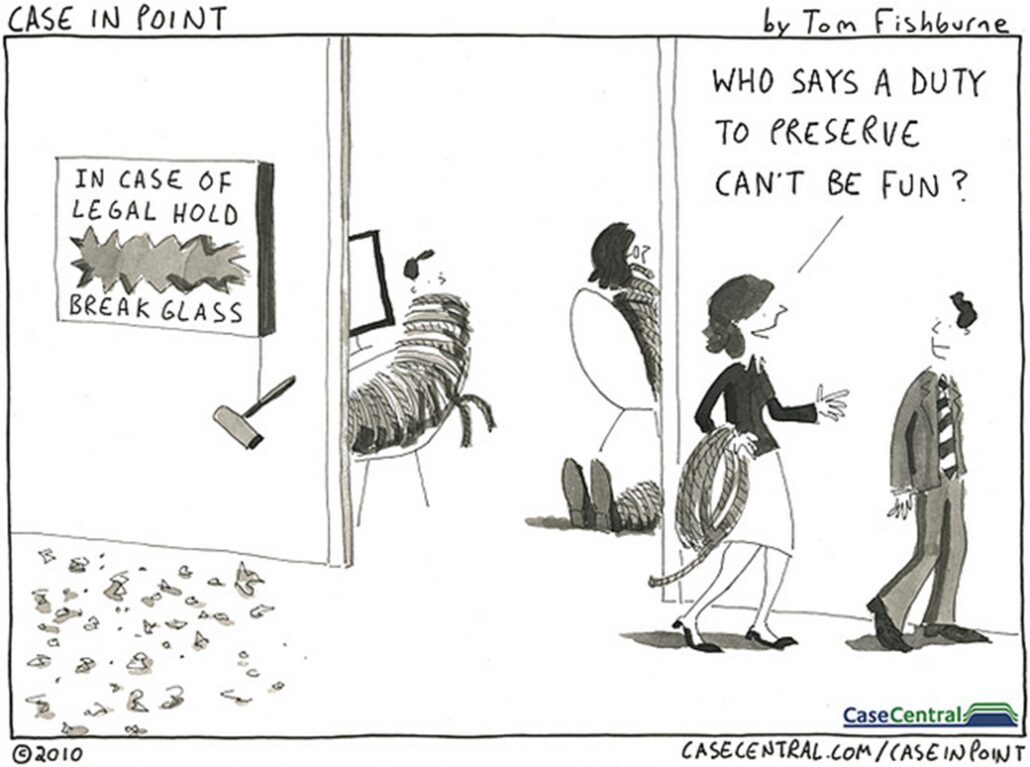Hey there, data detectives! It’s TechnoCat, Cat Casey, back with a critical concept that underpins the whole eDiscovery rollercoaster ride. I’m talking about the infamous ‘Legal Hold’. No, it’s not a wrestling move, but it might just save your legal bacon!
A Legal Hold – also donning the names of ‘litigation hold’ or ‘preservation order’ – is an unsung hero in our eDiscovery saga. Picture it as a court-issued or organizational directive, standing guard over all potentially relevant electronic and physical evidence. It’s like a trusty sidekick in your legal adventures, making sure crucial evidence stays safe, sound, and within reach.
The big mission of a Legal Hold? To fight off the villain of ‘spoliation‘. Now, that’s a fancy word for the deliberate or accidental destruction, alteration, or loss of evidence. Sort of like a crime within a crime scene – quite the twist, right?
By whipping out a Legal Hold, parties involved in a legal matter are obliged to pull out all the stops to preserve all potentially relevant info. No deletions, no alterations – just the unadulterated truth, ready for its spotlight during the litigation process.
So, why should you care about a Legal Hold? Well, without it, we might lose the very evidence we need to seek justice. And as we traverse this landscape of digital clues and cyberspace confessions, the last thing we want is our crucial evidence vanishing into thin air!

When do Legal Holds Happen?
let’s set sail into the tumultuous seas of Legal Holds and explore when these critical protective measures come into play.
The moment a Legal Hold gets its cue to enter the stage is when we spot the tell-tale signs of a “reasonable anticipation of litigation” or when we’re bound by the law to preserve potential evidence. Think of it as a red alert sounding when the storm of legal proceedings is on the horizon, prompting us to batten down the hatches and protect our precious cargo of Electronically Stored Information (ESI).
Let’s don our detective hats and explore the usual suspects – the trigger events that set the wheels of the legal hold process in motion.
- Reasonable Anticipation of Litigation: Our first clue that a legal dispute is brewing. This trigger comes into play when we have reasonable grounds to expect a legal spat, a potential lawsuit, arbitration, or a regulatory probe. It’s like a gathering storm cloud in the distance – a sign to buckle up and prepare for rough waters ahead.
- Notice of Claims: This clue’s a dead giveaway. We receive it in the form of demand letters, cease and desist notices, or other ominous signs of impending legal action. Once these harbingers of trouble land in our laps, it’s our cue to kickstart the preservation process.
- Regulatory Investigations: Now here’s a plot twist – Legal Holds aren’t exclusive to litigation! When regulatory bigwigs decide to snoop around with investigations or audits that could lead to legal proceedings, it’s our call to protect the evidence in play.
- Compliance Obligations: Oh, for our pals navigating the murky waters of heavily regulated sectors! Your journey through the realm of Legal Holds is often driven by compliance requirements. Laws and regulations may demand that you keep specific data safe and sound for a set period. Ignoring these rules can land you in hot water, so stay sharp, and let these compliance triggers guide your course.

What happens When a Litigation Hold is Triggered?
The trigger for preservation obligation has been pulled, now what? Well, the legal hold process is a straightforward one:
- Commencement of Legal Hold: When litigation is on the horizon, the first course of action is to issue a legal hold notice. This informs the necessary parties – those who might have information relevant to the litigation – of the situation. It’s like flipping on the siren, letting everyone know that preservation is now in action.
- Identifying the Relevant Data: The next step is akin to a treasure hunt, only instead of a treasure map, we’ve got potentially dozens or hundreds of sources where relevant data might be hiding. This could be email accounts, servers, databases, personal devices, and more – anywhere the relevant Electronically Stored Information (ESI) could be lurking.
- Preserving the Data: Having identified where the data is, we’ve got to make sure it stays safe and sound. This means ensuring that the data is safeguarded from deletion, alteration, or any other form of tampering.
- Constant Communication: Legal holds aren’t a set-it-and-forget-it operation. Ongoing communication is crucial – everyone involved needs to understand the importance of the hold and what they need to do to comply.
- Monitoring Compliance: Once the hold is in place, it needs to be monitored. This is like quality assurance for your legal hold, making sure the relevant data is being preserved and that everyone is playing by the rules.
- Releasing the Hold: Finally, when the legal matter has been resolved or the reason for the hold no longer exists, the hold can be lifted. This means the data can return to its usual retention schedule. But remember, just like any good adventure, the whole process should be thoroughly documented – you never know when you might need to revisit it.
What Happens If I Ignore a Legal Hold?
Neglecting to execute legal holds with precision can lead to some serious consequences, including hefty fines, unfavorable assumptions, and believe it or not, complete dismissal of a case. So, my dear legal eagles, it’s crucial to dot your i’s, cross your t’s, and make those legal holds rock solid to avoid these dire outcomes.
In the legendary battle of Zubulake vs UBS Warburg, a case that made waves in the legal world, U.S. District Court Judge Shira Shindlin took the stage and cast a spotlight on the critical importance of legal holds. With a firm hand, she declared that UBS had repeatedly failed in their duty to effectively locate, preserve, and produce crucial evidence to the plaintiff.
What’s worse, even court orders demanding action did little to sway their negligence. Therefore, the judge decided to drop the hammer and instructed the jury to draw an adverse inference. The result? Zubulake emerged victorious, scoring a staggering $29.2 million verdict in 2005. It was a glorious triumph that sent shockwaves through the legal community, compelling UBS to settle the case before facing the scrutiny of an appellate court.
Holding on!
And there you have it – a start-to-finish walk-through of what happens when a legal hold is triggered.
Until next time, this is Cat Casey, reminding you that in the world of legal tech, the only constant is change. Stay savvy, folks!
Interested in ACEDS’s educational content? Subscribe to the ACEDS Blog for weekly blog updates: https://aceds.org/aceds-blog/


